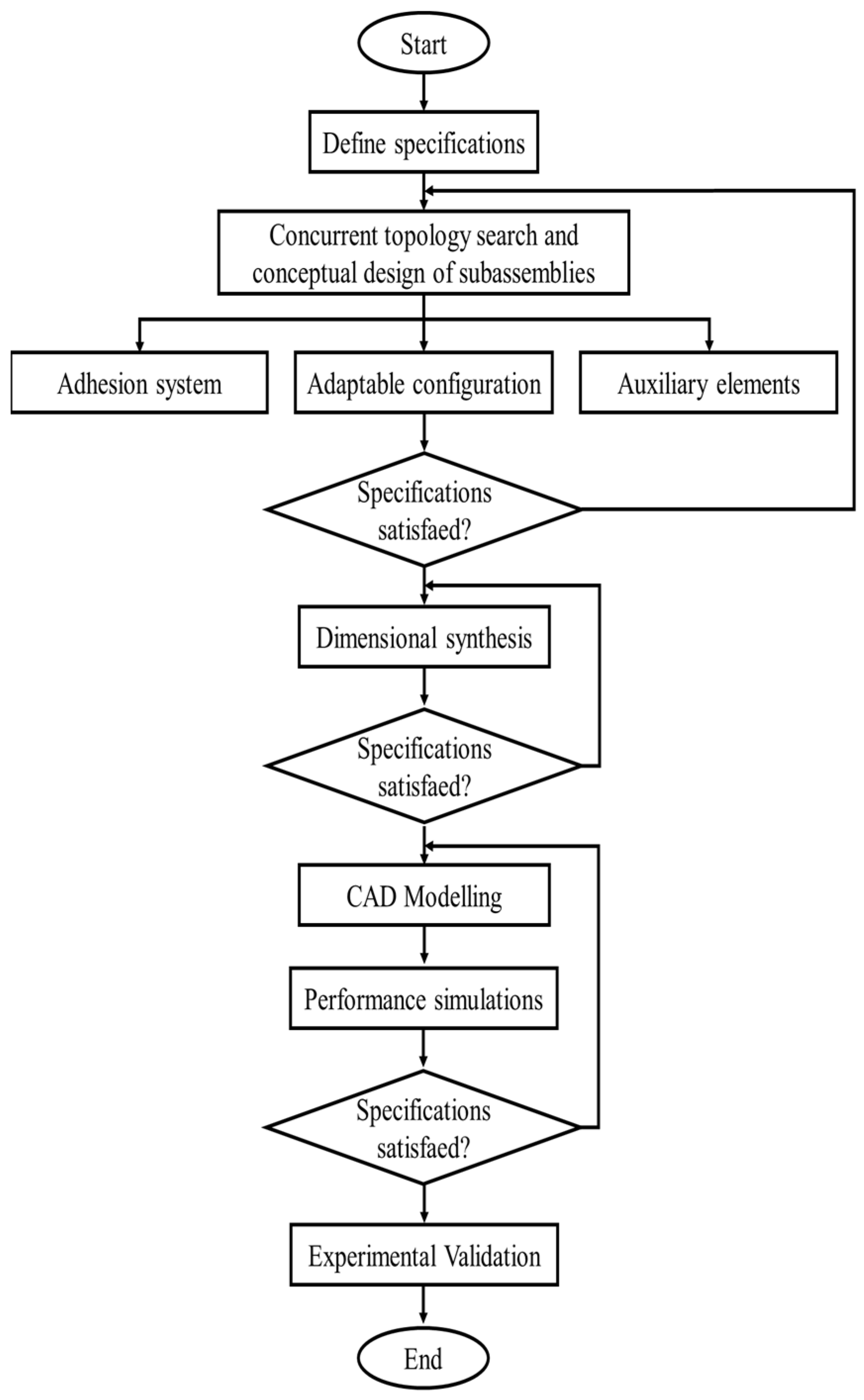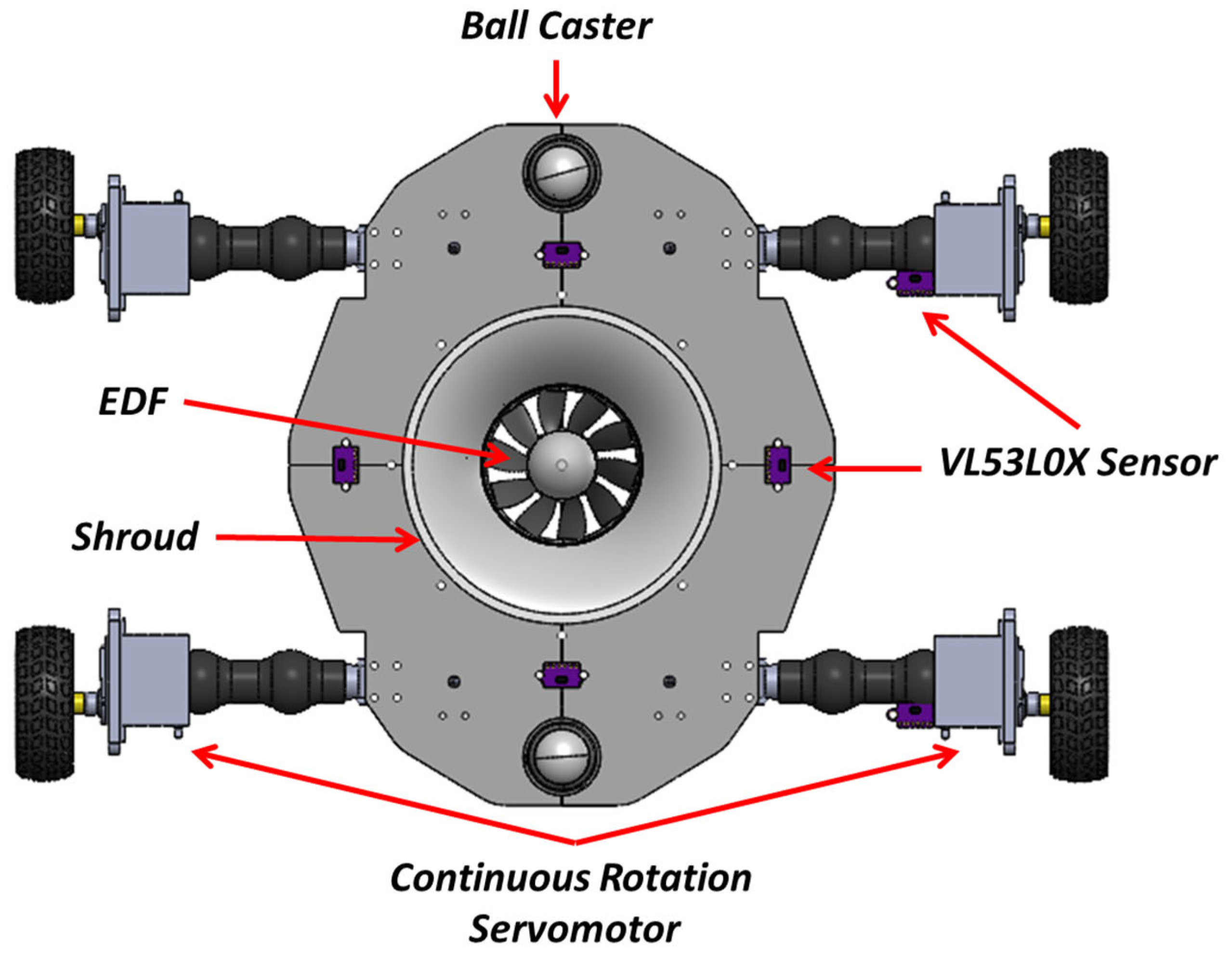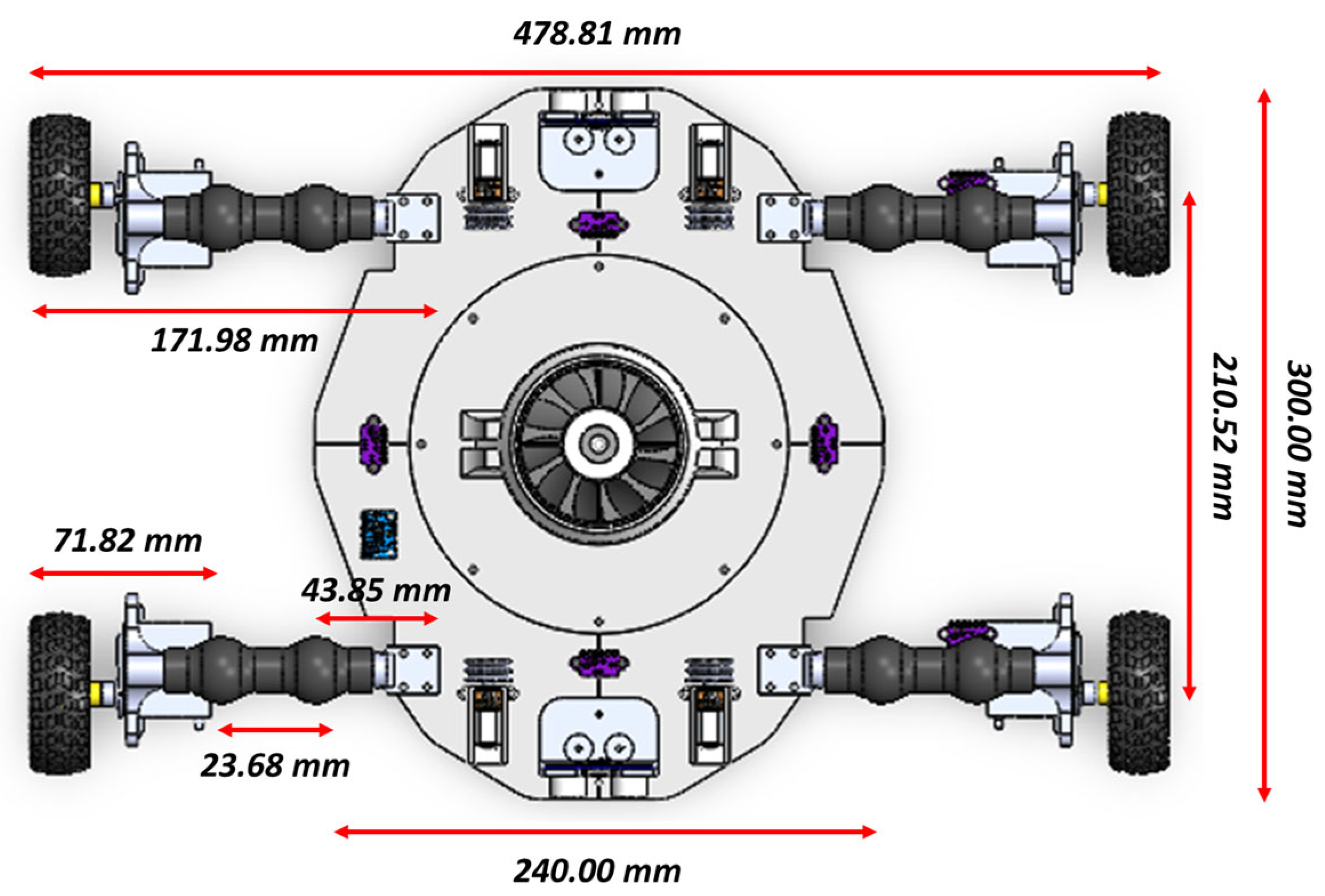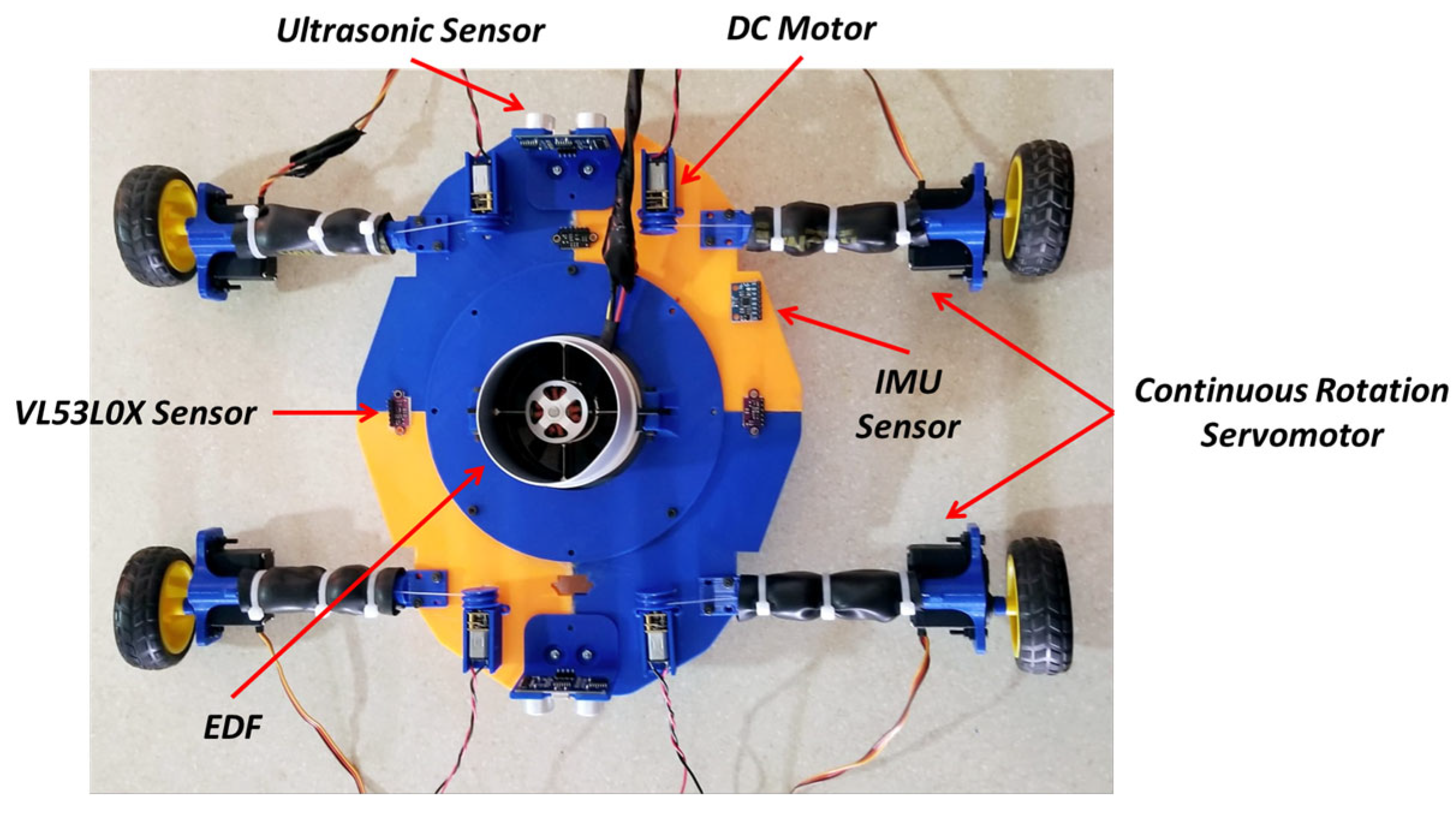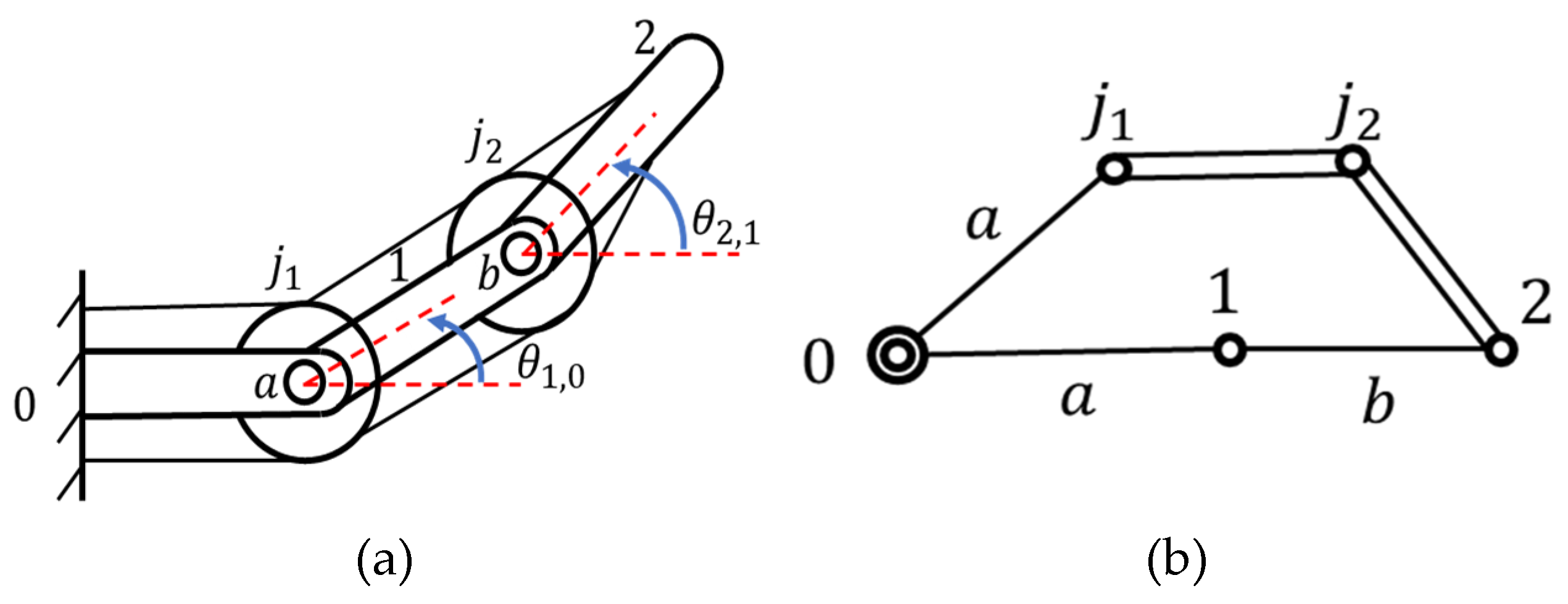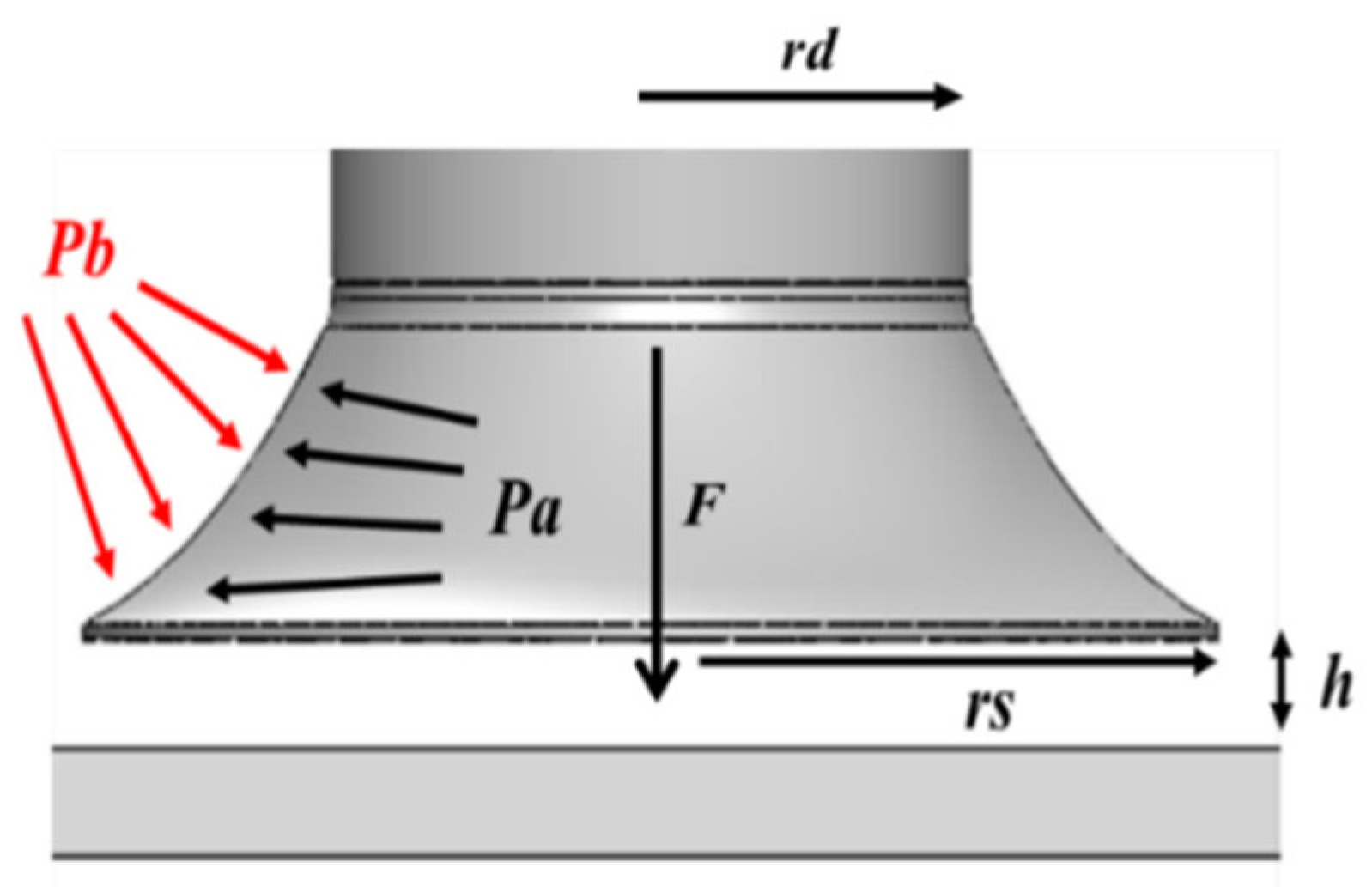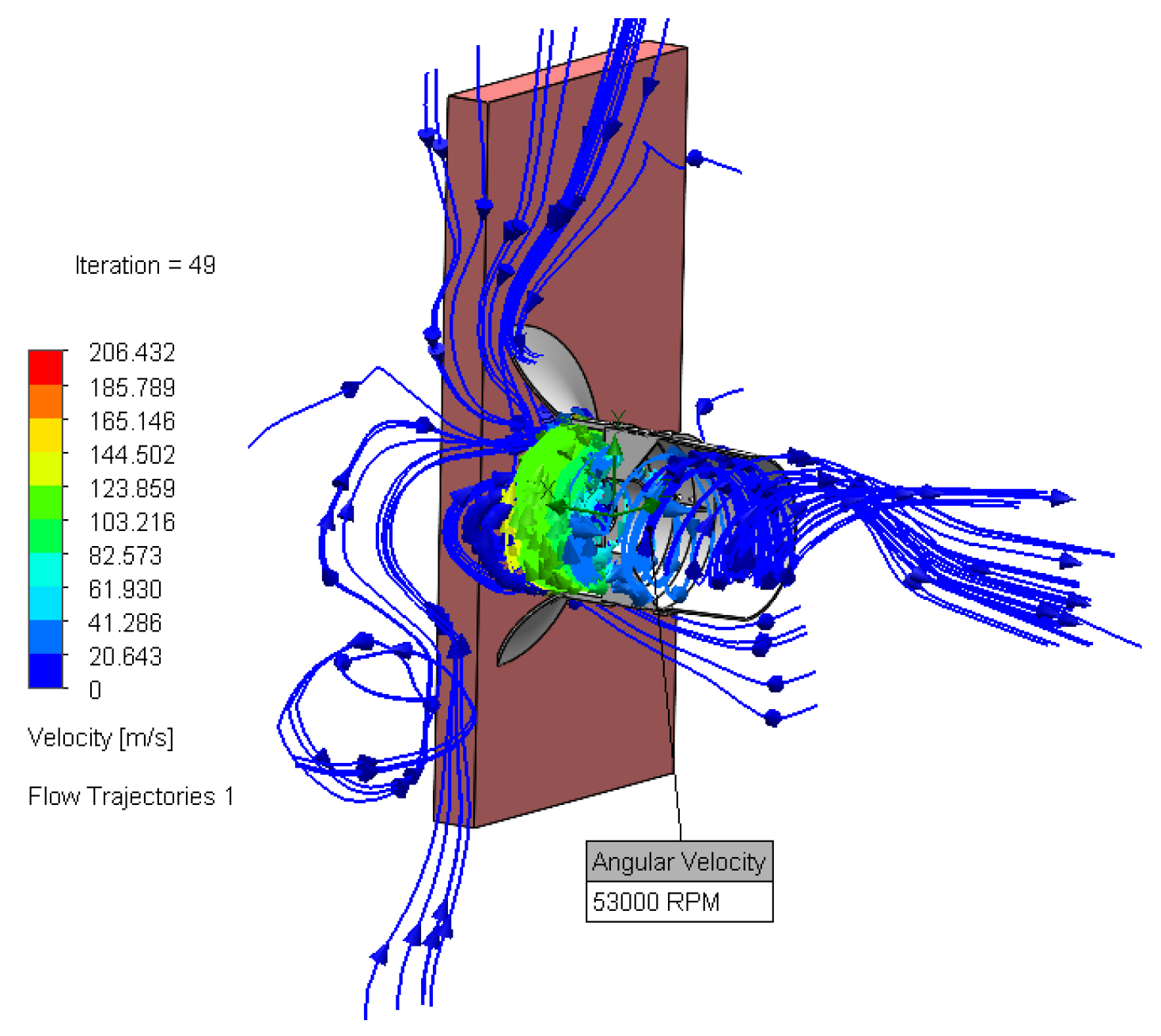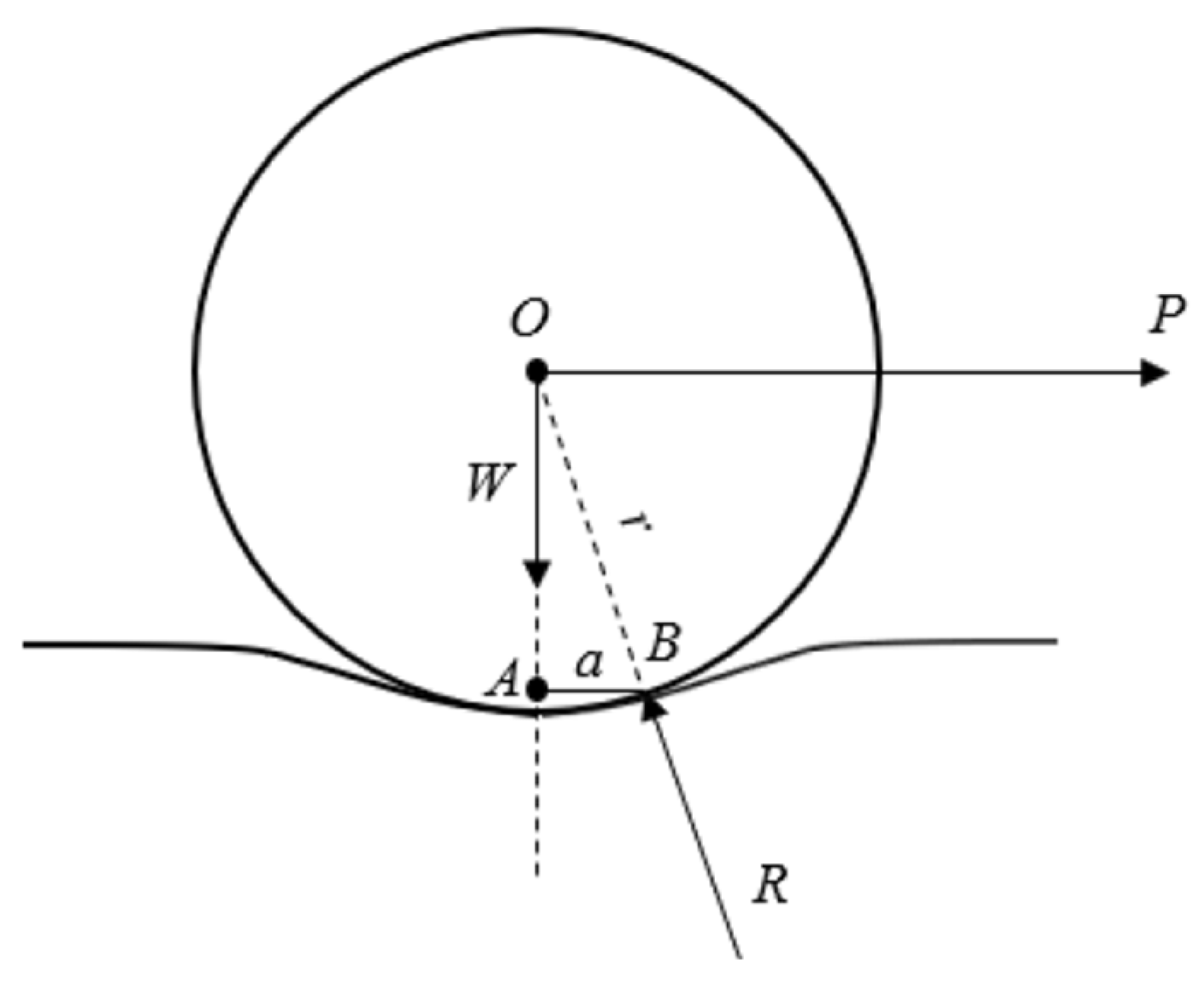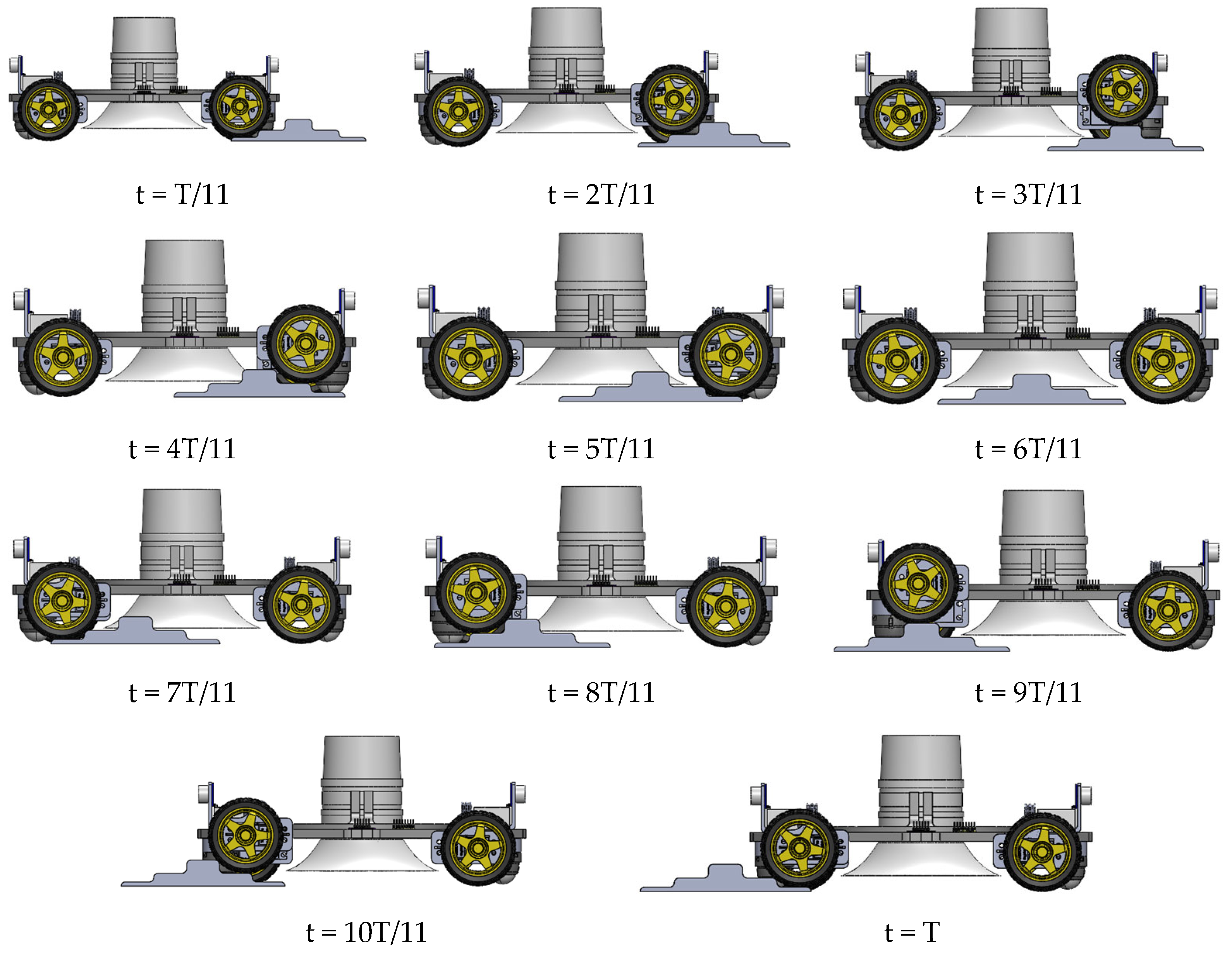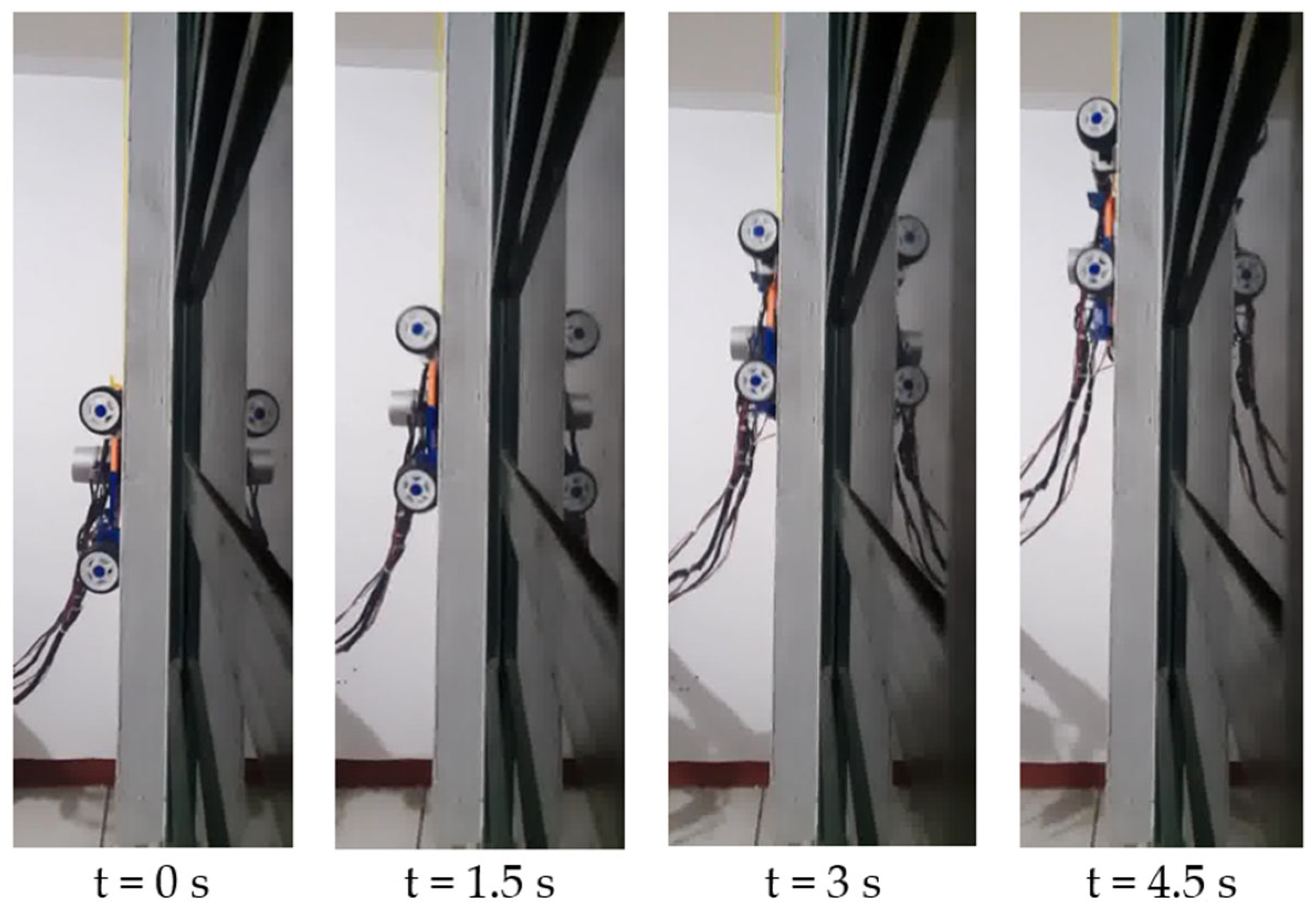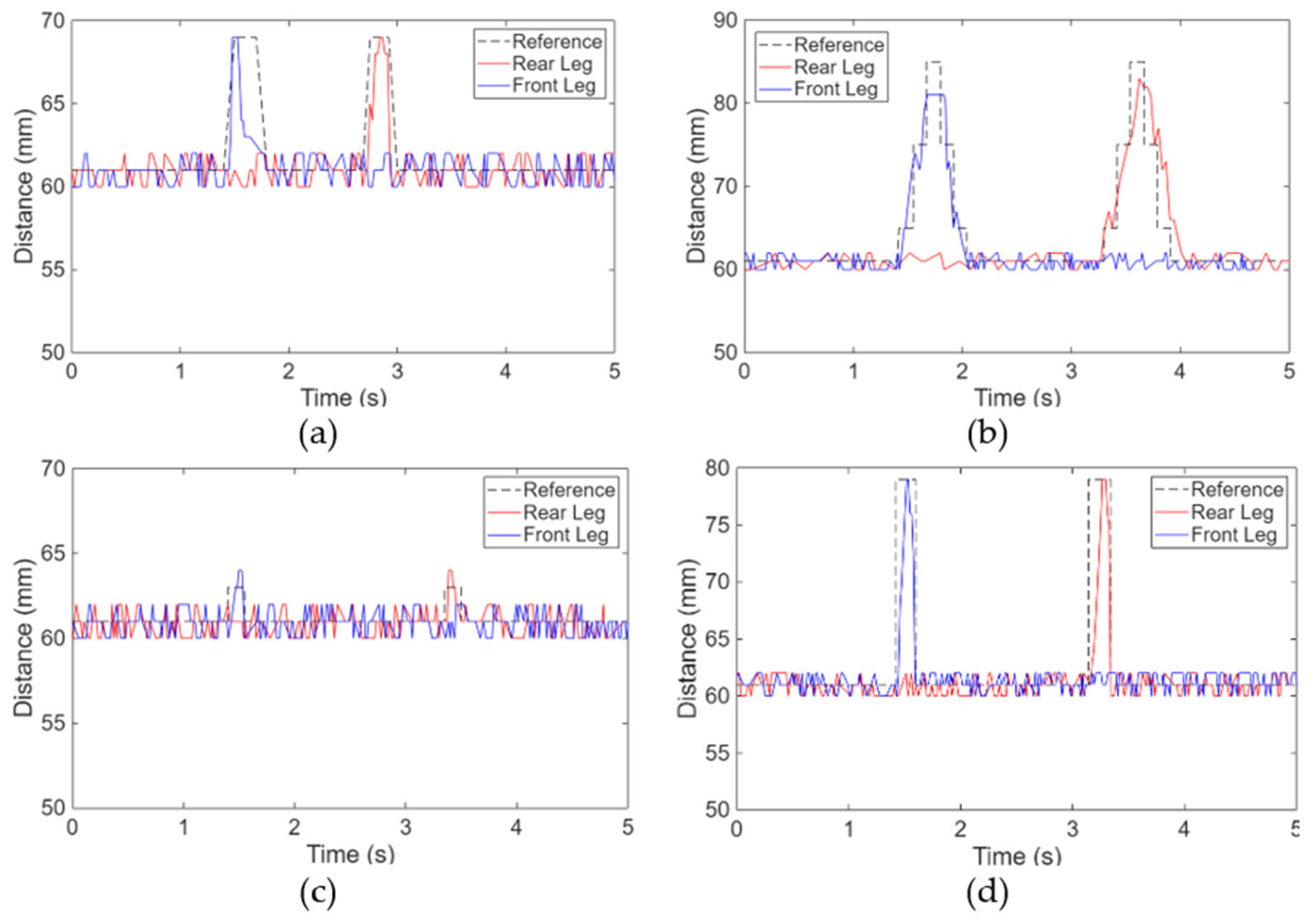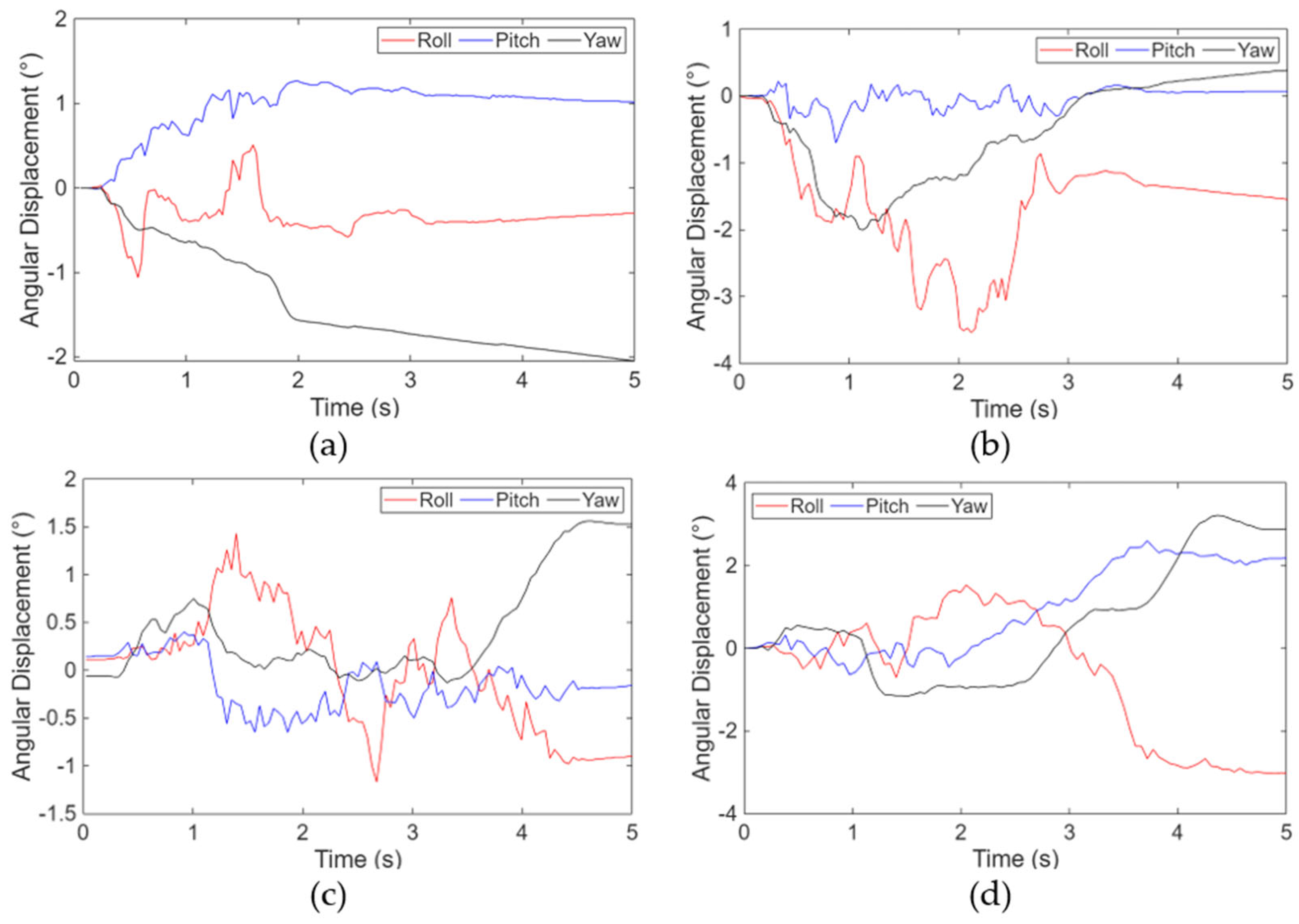1. Introduction
In recent years, the demands for service robotics are increasing, and service robots need to be able to perform various tasks in different surroundings [
1,
2,
3,
4]. Such service tasks require the interaction of the robot with the environment, facing obstacles, people, or rough terrains [
5]. In the particular case of vertical locomotion robots, the importance of professional application has been increased, such as inspection, maintenance, or cleaning, where the robot increases the operational efficiency and protects human health and safety [
5,
6,
7,
8]. In most of these service operations, the climbing robots need to navigate manifold and vertical human-made structures [
5,
6,
7,
8], like nuclear power plants, skyscrapers, or cultural heritage buildings. Almost all the current developed climbing robots have been designed to displace over flat surfaces, like glass or metal structures.
The locomotion issues and displacement limitations of this kind of robots are mainly due to their body configuration, shape, and adhesion principle. Thus, the robot should have a shape and configuration that allows displacing over all projections and reliefs without falling, and it must have a suitable adhesion technology to not harm the vertical surface. Specifically, for stone-made buildings, the climbing robots should adapt to all the irregularities, projections, and reliefs without causing any type of damage to the structure.
Within climbing robots there are different adhesion systems that can be used on rocky surfaces, such as pneumatic adhesion systems, mechanical adhesion, electro-adhesion, and chemical adhesion [
5,
6,
7,
8,
9]. In pneumatic adhesion systems the main adhesion is by negative pressure, which in turn can be performed by passive suction cups, active suction cups, and a vortex system [
10]. Passive suction cups are suitable only on very flat surfaces, such as glass; it is easy to combine them with different types of locomotion as in the Mapache robot in [
9] and either the vehicle presented in [
10] or the Dexter robot in [
11], which is equipped with two articulated feet. This principle has the great disadvantage that it is not robust against disturbances such as dust, in addition to the fact that the robot must be kept in motion since the suction cups lose the negative pressure due to small leaks. As for the active suction cups, an electric generation system by vacuum pump is used, or mechanically by venturi vacuum nozzles. These active systems have the advantage that they can work in more rugged terrain compared to passive suction cups and that they are capable of generating high attractive forces. This adhesion system is also simple to use with almost any type of locomotion, such as the Wall-Bot hexapod robot presented in [
12] or the robot with wheels in [
13].
The vortex system is a patented method of adhesion known as Vram (movement of regenerative vortex air), which generates adhesive forces through a vortex inside the robot. This vortex is created by a high-speed rotor and allows adhesion without additional sealing elements. Until now, only a few systems have been developed by using this principle, such as the Clarifying Climber robot by Clarifying Technologies [
14], the City Climber [
15], or the one presented in [
16], which are driven by wheels. This principle is still being investigated to improve the adhesion principle and to analyze its aerodynamics [
17].
In terms of mechanical adhesion systems, the system of claws or spines is available through a grip or clamping mechanism. These systems can be used on surfaces that are sufficiently rough so that the claws or spines find sufficient points of contact, or that provide protruding elements in a structure that can be grasped. Its main advantage lies in the energy consumption of the adhesion mechanism, its applicability to rough surfaces or structures, and its safety. The adhesion based on grip is especially very safe since even a loss of power does not necessarily lead to a fall in the system (if the mechanical configuration admits it). On the other hand, these systems are not very fast and are of limited maneuverability. In addition, its payload is low compared to robots that use magnetic attraction or a pneumatic system [
8]. This adhesion system can be found in robots such as CLIBO in [
18], the robot RISE in [
19], or the robot LEMUR in [
20].
On the other hand, electro-adhesion, a growing discipline in the field of climbing robot research, consists of electro-adhesive pads composed of conductive electrodes that generate electrostatic force or Van der Waals forces between the surface and the robot [
8]. Until now there have been only some robots that use this active adhesion system such as the vehicles presented in [
21,
22]. This technology seems to be a very promising approach since it is safe, energetically efficient, and robust with respect to different surfaces [
8].
Chemical adhesion systems include different adhesion methods, such as the adhesive-tapes-in-wheels combination presented in [
23], or multi-leg systems with sticky elastomers on the feet [
24]. The main advantage of this adhesion principle lies in its low energy consumption when the system is not moving, while during movement a certain force is needed to detach or separate the material from the surface. Another chemical principle of this adhesion system is the thermal glue [
25] that changes its characteristics depending on the temperature.
Nowadays, a commercial solution for vertical locomotion over non-ferromagnetic surfaces, like wood or stone, are the HB1 and HB2 robots by HausBots. HB2 is the most recent version of the HB1 robot. HB1 and HB2 implement AEROGrip Technology, a developed technology by HausBots, which consists of a suction and airflow hybrid which allows for high downforce generation on many surfaces, rough and smooth, ferrous and non-ferrous [
26]. This technology allows the robots to keep them added into the surface. As a locomotion system, they use the tack system that can allow overcoming small obstacles, such as wires and surface bolts [
26], but not adapting to bigger irregularities.
An easy solution to solve these issues is the use of underactuated mechanisms (UMs) as extremities for the robot. UMs can easily grasp an object with high adaptability to comply to its shape with low sensor information and an easy control strategy [
27,
28,
29]. Mechanical adaptability, as terminology, refers to the capacity of a UM to take the shape of any object and hold it with uniform pressure. It is defined as the relation between the joint state q and the external restrictions, which generates a change in the torque of the mechanism. Mechanical adaptability is measured by the relation between the joint’s displacement and the generated torque, until reaching a locking point where the mechanism can no longer move [
28,
29,
30]. Thus, an infinity value of adaptability determines a free motion and the initial contact state, where the UM can move until it contacts the object; meanwhile, a zero value of adaptability determines the grasping convergent state, where the UMs no longer move, and the contact force is higher [
31].
The aim of this paper is to present the design of an adaptable service robot for vertical locomotion, which is made up of a body with four wheeled legs. Each leg is composed by a tendon-driven underactuated mechanism with two rotational joints and a wheel in the end extremity. The legs have a rubber cover. The main function of this cover is as a spring for each joint, allowing the legs to return to their main position when the tendon is not driven, as well as allowing to improve the mechanical adaptability of the legs. An Electric Ducted Fan (EDF) is used for a vortex system as the adhesion principle. The vortex system is located at the middle of the body. Theoretical backgrounds and open issues are addressed by considering some challenging problems such as mechanical adaptability modeling as well as kinematic and static analysis. Laser sensors are mounted over the robot to measure the adaptability of the robot, between the legs and body, at each time of the experimental tests for vertical locomotion. Also, an IMU sensor is mounted to measure the angular displacements over each axis. This paper demonstrates the suitability and feasibility of the proposed service robot for vertical locomotion.
4. Experimental Evaluation
An experimental evaluation of the robot has been carried out to demonstrate its feasibility and features over a controlled environment. The experimental evaluation consists in evaluating the performance of the proposed robot during a vertical locomotion over a concrete wall. To validate the performance, ten different tests were carried out; each test was performed with a different obstacle.
Table 8 presents the proposed experimental tests and the obstacle used in each one. Test 1 is used as reference test, with no obstacle and a free vertical locomotion, to compare it with the other tests.
Figure 15,
Figure 16,
Figure 17 and
Figure 18 present the desired behavior of the robot, and adaptation to obstacles, during the experimental tests.
A LiPo battery (6s) is used as the main power supply of the robot; a voltage regulator allows setting a voltage of 5 volts to operate an Arduino UNO and the servomotors (MG995); an ESC controller is used to control the speed of the EDF; and a servo tester regulates the PWM to the ESC controller (see
Figure 19). MG995 servomotors are used to drive the wheels, with a maximum torque of 15 kg-cm. Different sensors have been mounted over the robot to test its efficiency. An IMU sensor (GY-87) is mounted over the body to obtain the behavior of the angular displacements along the tests; thus, one can obtain the rotation during a straight, forward displacement. An ultrasonic sensor (HC-SR04) is mounted in the front of the body of the robot; thus, one can obtain its linear velocity by the relation between the displaced distance and the time lapse. Four laser sensors are located over the body to measure the distance between the body and the surface. One laser sensor is mounted over the servomotor of each leg (see
Figure 1); thus, the distance between the leg and the wall can be measured. The above allows relating the displacement of the leg and the displacement of the body along the experimental tests; namely, it is possible to measure the adaptability of the robot when it is carrying out a vertical locomotion over different obstacles. Unlike the mechanical adaptability of UMs, this approach allows measuring the percentage that the leg is complying to the obstacle’s shape.
Figure 20 and
Figure 21 present a time lapse of the robot during the experimental evaluation for tests one and four, respectively. To measure the adaptability of the robot over the obstacles Equation (19) is used, where
is the relative error between the theoretical high and the experimental high. The theoretical high is the sum of the distance of the leg to the wall (61 mm) and the high of the obstacle. The experimental high is the sensed distance between the leg and the wall.
There are four representative tests used to demonstrate the feasibility of the robot, tests 2, 4, 5, and 10. The distance between the body and the wall during these three representative tests is presented in
Figure 22, where it is possible to note that the body stays always parallel to the wall with a continuous distance of 52 mm with a variation of ±1 mm.
Figure 23 presents the behavior of the legs during the representative tests. It is possible to appreciate that the legs of the robot are reaching the maximum high of each obstacle, according with
Table 8. Therefore, if the body of the robot keeps straight and parallel to the wall, and if the legs are taking the shape of the obstacles, the robot is adapting into the shape of the obstacles during its vertical locomotion. The angular displacements, obtained with the IMU, are presented in
Figure 24. Roll and pitch are the angular displacements for the x- and y-axis, respectively. The variation in the behavior of these axes is mainly due to the vibrations of the EDF; meanwhile, yaw (z-axis) represents the turning of the robot due to the vertical locomotion and the adaptability to the obstacles. Comparing
Figure 23 and
Figure 24, one can note that the variation in the angular displacements coincides with the movement of the legs during the test, (see
Figure 23a and
Figure 24a.
Table 9 presents the summary of the experimental results of the robot.
Table 10 presents the average measured values of the robot performance. To obtain the mean power consumption, an ACS712 current sensor has been used. The maximum power consumption, considering the servomotor and dc motor, is 1.54 watts for each leg; therefore, for the four legs it is 6.16 watts. Moreover, for the vortex system, the mean power consumption of the EDF is 1900 watts. Thus, the mean total power consumption of the robot is 1906.16 watts.
Table 11 presents the statistical data of the carried out experimental evaluation.
